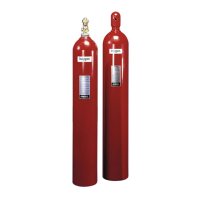TESTING ELECTRIC DETECTION/ACTUATION SYSTEM
– AUTOPULSE CONTROL SYSTEM
In order to properly test the electric detection and actuation
system, refer to the appropriate AUTOPULSE control
system installation, operation, and maintenance manual.
When HF electric actuator is actuated correctly, the piston
in the bottom of the actuator will be locked in the down
position.
TESTING ELECTRIC DETECTION SYSTEM – ANSUL
AUTOMAN II-C RELEASE
When utilizing an ANSUL AUTOMAN II-C release for elec-
tric detection or in combination with an AUTOPULSE Con-
trol System, refer to ANSUL AUTOMAN II-C Releasing
Device Installation, Operation, and Maintenance Manual,
Part No. 17788, or for explosion-proof version, Part No.
31496, for detailed information.
TESTING SELECTOR VALVE
When utilizing selector valves in the distribution piping net-
work, make certain all selector valve internal actuators are
in the “SET” position.
DISCHARGE TEST
The authority having jurisdiction may require an INERGEN
system discharge test. In preparing for a discharge test, the
following guidelines may help:
1. Perform a complete maintenance exam prior to per-
forming the discharge test. This will confirm that the
system will function properly.
2. Inform all personnel that a discharge test will be con-
ducted. Everyone should be aware that various equip-
ment will shut off or turn on. No one should be in the
hazard area during the discharge.
3. If necessary, perform an enclosure integrity (door fan)
test prior to running the INERGEN system discharge
test. This will confirm that total venting area is not too
great for the hazard to adequately contain the desired
INERGEN agent concentration.
4. Set up the recording equipment outside of hazard
area. Ansul recommends using the following equip-
ment:
–Nova Model 308 BWP portable oxygen and carbon
dioxide analyzer
– M-Tek Model 312 two pen, four in., multi-range,
multi-speed chart recorder
Ansul recommends that the oxygen and carbon diox-
ide concentrations be monitored from a single point
within the protected space.The source for the monitor-
ing point will be the hazard most likely considered the
fire source. In the case of total room protection with
multiple hazards, the monitoring point should be
halfway up at the center of the room.
5. NOTE: If the system is to be fired manually, discon-
nect the electric actuator to prevent firing from a pres-
sure switch and control panel. Actuate INERGEN sys-
tem and monitor recording equipment.
In order to meet the design concentration, the Oxygen
and CO
2
levels must meet the values in Table 1. The
oxygen concentration must not exceed 15% throughout
the hold time determined by the AHJ.
TABLE 1
Reading should start one minute plus meter delay time
from system actuation. Meter delay time, depending on
length of tubing, could be as long as 30 to 60 seconds.
6. After concentration monitoring is complete, open
doors and, if possible, windows, to completely air out
hazard area.
7. Reset control panel and all auxiliary equipment. Make
certain all equipment has returned to its normal oper-
ating status.
SECTION VII
UL EX-4510 12-1-01 Page 7-2
Testing And Placing In Service
CAUTION
!
HF Electric Actuator, Part No. 73327, must not be
installed on INERGEN cylinder valve during test. If
installed, testing of the electric detection system will
cause actuation and discharge of the fire suppression
system.
Oxygen % CO
2
%
(Equal to or (Equal to or
INERGEN % Less Than) Greater Than)
34.2 13.8 2.7

